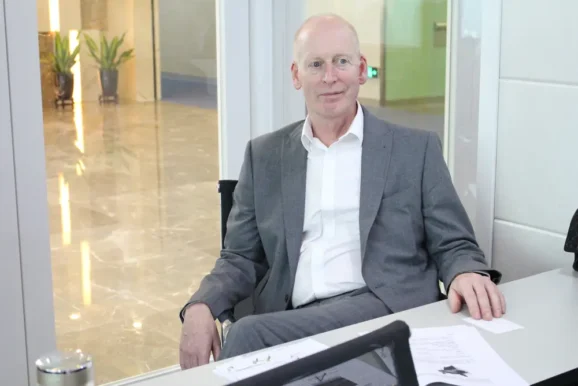Get in the Game

John E. Kaye
- Published
- Home, Opinion & Analysis

Goal-setting in the business world can make the difference between finishing first or last. Corporate trainer Pete Sutton highlights the parallels between sporting and business success to put us on the winning track
As the 2024 Olympic and Paralympic Games draw to a close, we’ve all been inspired by the dedication and resilience of the world’s top athletes. Their remarkable performances often seem superhuman, as if they operate on a different level from the rest of us. But the truth behind their success lies not just in natural talent but in the principles and practices that drive their performance – principles that can be applied to the business world.
There is a striking parallel between the disciplines of sport and business. High performers in both arenas thrive through a combination of motivation, strategic goal-setting, mental resilience, and consistent, focused effort. By understanding and adopting these methods, business leaders can enhance their own performance and that of their teams.
Elite athletes achieve their goals by setting clear, overarching objectives and meticulously breaking them down into manageable milestones. This approach, combined with unwavering dedication and a passion for their craft, propels them to success. In contrast, many business professionals overlook this structured process, potentially limiting their achievements.
I have delivered corporate training for 20 years and in that time have found goal-setting among professionals to be surprisingly rare. Many of the leaders I’ve worked with thought of it as a ‘task’ akin to admin – something to be delegated or, if possible, avoided altogether. This chimes with research that suggests 84 per cent of people don’t have a goal at all. Of these, only about three per cent write them down, and just eight per cent go on to achieve them.
In my experience, people generally don’t set goals for the following three simple reasons:
– Their goals are drawn up for them by employers. For many people, the actions they take at work to complete their KPIs / annual objectives will result in them achieving enough to feel satisfied. Or, in other words, they have realised a goal by default, despite that goal being defined for them.
– Their goals compete with or take second place to life – the stuff happening around them on a daily basis. These day-to-day tasks take up a lot of time and become the priority over more aspirational or challenging objectives.
– Their goals may seem too tough or too big to realise, or simply don’t enthuse them.
Like Olympic athletes, professionals must be motivated, enthusiastic and excited by their goals. They need to be able to imagine the positive outcomes of realising those goals – of winning their own gold medal.
So how do we start thinking about the type of goal that could engage our delight and our energy? Many coaches rely on the ‘SMART’ goal-setting approach: Specific, Measureable, Achievable, Realistic, and Timed. But while SMART goals can be effective for setting structured objectives, they also have their drawbacks. SMART can, for instance, limit creativity due to excessive specificity, present challenges in measuring qualitative outcomes, and cause potential frustration from overly ambitious targets. The focus on time constraints may also create undue pressure, while the rigid structure might overlook emotional motivation and lead to tunnel vision, where the broader context is neglected.
With these drawbacks in mind, SMART should be seen as a guideline rather than a strict formula. Much of my work is about repurposing these guidelines and turning a rigid set of parameters into more helpful steps. My own version of SMART, which draws on my own background in NLP and as a clinical hypnotherapist, has a proven track record among thousands of professionals worldwide:
S: Sub-consciously agreeable
Our subconscious mind, which runs our body even when we’re asleep, is relatively straightforward and responds well to clear, direct instructions. It’s a powerful ally that helps us achieve our true objectives, especially when our goals align with our core values. Since the subconscious is the seat of our emotions and values, it reinforces our determination to succeed when our goals are in harmony with what truly matters to us.
Try this: Before setting your goals, be clear, direct, and honest with yourself. Set only goals that align with your own core values, whatever they may be.
M: Meaningful
In corporate training, I frequently challenge the idea that we work purely for money because, in truth, we work for what money represents, such as paying off a mortgage, funding a holiday, supporting a cause we care about, or fulfilling other personal desires. When we acknowledge these underlying reasons and incorporate them into our goals, we give those goals deeper meaning. This clarity ignites our imagination and sparks genuine motivation to succeed.
Try this: Write down a goal that excites you or gives you a little thrill of nervousness for daring to believe in it. Picture what you’ll see, hear, and feel when you achieve it. Make your goal real and compelling, and ensure it aligns with your values.
A: Adaptable
Traditional SMART goal-setting often treats goals as if they are set in stone – fixed and unchangeable. However, our lives can and do change, and our goals should adapt accordingly.
Try this: It’s important to be kind to yourself when you need to reassess and reset your goals – this isn’t a failure. Just like with weight loss or quitting smoking, success might come after multiple attempts. So revisit your goal every week and change it if you need to.
R: Resilient
To achieve our goals without burning out, we need to manage our stress levels. It’s helpful to identify aspects of our goals that are beyond our control and learn to relax about them. For example, if our goal hinges on completing a project or earning a qualification, we should have a backup plan in case things don’t go as expected.
Try this: Consider alternative paths to your goal. What other routes can get you to the same destination?
T: Thrilling
If achieving a goal doesn’t evoke a strong positive emotion, was the time and effort involved really worth it? I think not. We need to feel that excitement now, not just when we reach the finish line. Relying solely on willpower won’t sustain us for a goal that’s two years away – we need to be genuinely excited about where we’re headed so it doesn’t feel like a constant struggle.
Try this: Visualise reaching your goal and focus on the positive emotions it brings. If it excites you and feels rewarding, you’re on the right track. If not, consider refining your goal until it truly inspires you.
Just as elite athletes continually refine their training and adapt to challenges, business professionals must regularly reassess and refine their own goals to stay aligned with their changing lives and ambitions. In doing so, they can maintain the drive and passion needed to reach their peak performance. The road to success in both sport and business is paved with commitment, resilience, and the right mindset – qualities that can be cultivated by anyone willing to embrace these simple principles.

Pete Sutton is an internationally acclaimed trainer with extensive experience in Europe, Asia, and the Middle East. With a 20-year career at IBM, where he also earned his MBA, he transitioned into personal development, leadership, and management training. For the past 17 years, he has empowered individuals through his training programs, which draw on his background and training in NLP, clinical hypnotherapy, and as a DISC practitioner and certified Dale Carnegie trainer.
Main image: Courtesy Alex Kinkate/Pexels
Sign up to The European Newsletter
RECENT ARTICLES
-
 Britain is finally having its nuclear moment - and it’s about time
Britain is finally having its nuclear moment - and it’s about time -
 Forget ‘quality time’ — this is what children will actually remember
Forget ‘quality time’ — this is what children will actually remember -
 Shelf-made men: why publishing still favours the well-connected
Shelf-made men: why publishing still favours the well-connected -
 European investors with $4tn AUM set their sights on disrupting America’s tech dominance
European investors with $4tn AUM set their sights on disrupting America’s tech dominance -
 Rachel Reeves’ budget was sold as 'fair' — but disabled people will pay the price
Rachel Reeves’ budget was sold as 'fair' — but disabled people will pay the price -
 Billionaires are seizing control of human lifespan...and no one is regulating them
Billionaires are seizing control of human lifespan...and no one is regulating them -
 Africa’s overlooked advantage — and the funding gap that’s holding it back
Africa’s overlooked advantage — and the funding gap that’s holding it back -
 Will the EU’s new policy slow down the flow of cheap Chinese parcels?
Will the EU’s new policy slow down the flow of cheap Chinese parcels? -
 Why trust in everyday organisations is collapsing — and what can fix it
Why trust in everyday organisations is collapsing — and what can fix it -
 In defence of a consumer-led economy
In defence of a consumer-led economy -
 Why the $5B Trump–BBC fallout is the reckoning the British media has been dodging
Why the $5B Trump–BBC fallout is the reckoning the British media has been dodging -
 WPSL Group unveils £1billion blueprint to build a global golf ‘super-group’
WPSL Group unveils £1billion blueprint to build a global golf ‘super-group’ -
 Facebook’s job ads ruling opens a new era of accountability for artificial intelligence
Facebook’s job ads ruling opens a new era of accountability for artificial intelligence -
 Robots can’t care — and believing they can will break our health system
Robots can’t care — and believing they can will break our health system -
 The politics of taxation — and the price we’ll pay for it
The politics of taxation — and the price we’ll pay for it -
 Italy’s nuclear return marks a victory for reason over fear
Italy’s nuclear return marks a victory for reason over fear -
 The Mamdani experiment: can socialism really work in New York?
The Mamdani experiment: can socialism really work in New York? -
 Drowning in silence: why celebrity inaction can cost lives
Drowning in silence: why celebrity inaction can cost lives -
 The lost frontier: how America mislaid its moral compass
The lost frontier: how America mislaid its moral compass -
 Why the pursuit of fair taxation makes us poorer
Why the pursuit of fair taxation makes us poorer -
 In turbulent waters, trust is democracy’s anchor
In turbulent waters, trust is democracy’s anchor -
 The dodo delusion: why Colossal’s ‘de-extinction’ claims don’t fly
The dodo delusion: why Colossal’s ‘de-extinction’ claims don’t fly -
 Inside the child grooming scandal: one officer’s story of a system that couldn’t cope
Inside the child grooming scandal: one officer’s story of a system that couldn’t cope -
 How AI is teaching us to think like machines
How AI is teaching us to think like machines -
 The Britain I returned to was unrecognisable — and better for It
The Britain I returned to was unrecognisable — and better for It



























